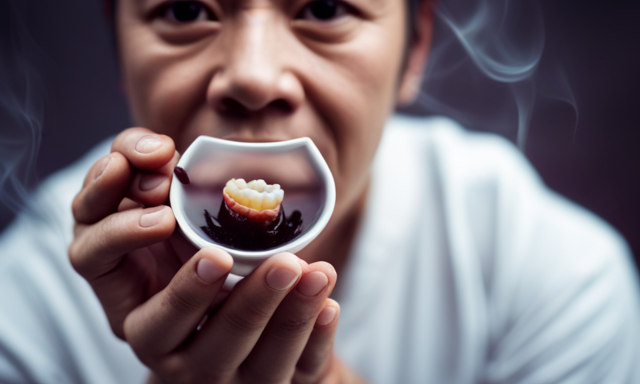Have you ever experienced the excruciating pain of sipping on a soothing cup of oolong tea, only to be met with an intense toothache? If so, you’re not alone. Many of us have been perplexed by this perplexing phenomenon.
In this article, we will delve into the intriguing world of tooth sensitivity and the role that oolong tea plays in exacerbating it. Tooth sensitivity occurs when the protective layer of enamel on our teeth becomes compromised, exposing the underlying dentin and nerve endings.
Oolong tea, with its unique composition, contains substances known as tannins that can irritate the nerve endings and trigger tooth pain. Additionally, the pH levels and temperature of oolong tea can further aggravate tooth sensitivity.
But fear not, for there are remedies and steps you can take to alleviate this discomfort. By understanding the science behind tooth sensitivity and making some adjustments to your oral hygiene habits, you can continue to enjoy your favorite oolong tea without the dreaded toothache.
So, let’s dive in and uncover the secrets behind this perplexing tea-induced tooth pain.
Key Takeaways
- Oolong tea, as an acidic food, can contribute to tooth sensitivity and pain.
- Limiting consumption of acidic foods and drinks, including oolong tea, can help alleviate tooth pain and protect oral health.
- Using toothpaste formulated for sensitive teeth can help block pain caused by oolong tea.
- Seeking professional dental advice is important to identify the causes of tooth sensitivity and receive appropriate treatments, such as desensitizing toothpaste or dental fillings.
Understanding Tooth Sensitivity
Do you ever wonder why oolong tea is causing your teeth to hurt? Tooth sensitivity can be attributed to various factors, one of which is tooth enamel erosion.
Oolong tea, like other acidic beverages, can contribute to the erosion of tooth enamel over time. This erosion exposes the underlying dentin layer, which contains tiny tubules that lead to the nerves of the teeth, causing sensitivity and discomfort.
To alleviate this issue, using toothpaste specifically formulated for sensitive teeth can help. These toothpastes contain ingredients like potassium nitrate or strontium chloride that can help reduce tooth sensitivity by blocking the nerve signals.
Now that we understand why oolong tea can cause tooth sensitivity, let’s delve into the composition of oolong tea and explore how it may impact our oral health.
The Composition of Oolong Tea
The unique blend of ingredients in oolong tea, such as polyphenols and tannins, might be the reason behind the discomfort in your teeth. Oolong tea is known for its distinct taste preferences and health benefits.
It contains polyphenols, which are antioxidants that can help protect against tooth decay and gum disease. These compounds have been shown to inhibit the growth of bacteria that cause oral health problems.
However, oolong tea also contains tannins, which are a type of organic compound that can cause teeth sensitivity. Tannins have astringent properties, meaning they can cause the proteins in your mouth to bind together, leading to a drying effect. This can result in tooth sensitivity and discomfort.
Understanding the role of tannins in oolong tea can help us further explore their impact on tooth health.
The Role of Tannins
Tannins are naturally occurring compounds found in various plant-based foods and beverages. They are known for their astringent taste and ability to bind to proteins and other molecules. When consumed in excess, tannins can cause teeth sensitivity by binding to the tooth enamel, making it more porous and susceptible to pain and staining.
Oolong tea, like many other types of tea, contains tannins, and its consumption can lead to tooth sensitivity if consumed in large quantities or if one already has weakened tooth enamel.
What are tannins and their effects on teeth
You’ll be surprised to learn that those pesky tannins in oolong tea can wreak havoc on your teeth, causing that dreaded tooth sensitivity. Tannins are a class of compounds found in many plants, including tea leaves. They are responsible for the astringency and bitter taste in tea.
When it comes to your teeth, tannins can have two major effects. Firstly, they can cause staining by binding to the proteins in your teeth, resulting in discoloration over time. Secondly, tannins have been shown to affect gastrointestinal health, leading to digestive issues.
It’s important to note that the tannin content in oolong tea can vary depending on factors such as processing and brewing time. Understanding the impact of tannins on tooth sensitivity is crucial for maintaining optimal oral health.
Transitioning into the next section, let’s explore the tannin content in oolong tea and its impact on tooth sensitivity.
Tannin content in oolong tea and its impact on tooth sensitivity
Prepare to be amazed by the surprising impact of oolong tea’s tannin content on tooth sensitivity. It can leave your pearly whites feeling like they’ve been caught in a whirlwind.
Tannins are a type of polyphenolic compound found in various foods and beverages, including oolong tea. These compounds have been known to cause astringency and staining, but their effects on tooth sensitivity have often been overlooked.
When consumed, tannins in oolong tea can bind to proteins in saliva and form complexes that temporarily reduce the protective layer on tooth enamel. This can expose the underlying dentin, leading to increased sensitivity to hot, cold, and acidic stimuli.
If you experience tooth sensitivity after drinking oolong tea, it’s advisable to consult with a dental professional for remedies and seek their advice on maintaining optimal oral health.
Now, let’s explore the fascinating world of pH levels in oolong tea.
pH Levels in Oolong Tea
Oolong tea is known for its unique flavor and health benefits, but it’s acidic nature can have a negative impact on tooth enamel. The pH balance of oolong tea plays a significant role in tooth sensitivity, as it can erode the protective layer of enamel, leading to tooth pain and sensitivity.
It’s important to be mindful of the pH levels in oolong tea and take steps to minimize any potential damage to our teeth.
Acidic nature of oolong tea and its effect on tooth enamel
Indulging in the delightful tang of oolong tea might gradually erode your tooth enamel due to its acidic properties. The acidic nature of oolong tea can lead to tooth enamel erosion. This is a process where the outer layer of the teeth starts to wear away. Dental enamel erosion occurs when the acids in the tea come into contact with the teeth, causing them to become weak and more susceptible to damage. Over time, this can result in tooth sensitivity and discomfort. Understanding the role of pH balance in tooth sensitivity will further explain how oolong tea can affect your dental health.
The role of pH balance in tooth sensitivity
After discussing the acidic nature of oolong tea and its effect on tooth enamel, let’s now delve into the role of pH balance in tooth sensitivity.
Tooth sensitivity occurs when the protective layer of enamel becomes worn down, exposing the underlying dentin and nerve endings. The pH balance of our mouth plays a crucial role in this process. When the pH level is too low, it indicates high acidity, which can erode the enamel and lead to tooth sensitivity.
Maintaining a proper pH balance is essential for oral health. To alleviate tooth sensitivity, there are several remedies available, such as using desensitizing toothpaste, avoiding acidic foods and beverages, and maintaining good oral hygiene practices. These remedies can help restore the pH balance in the mouth and alleviate tooth sensitivity.
Moving forward, let’s explore the next aspect: temperature sensitivity.
Temperature Sensitivity
When you take a sip of hot oolong tea, your teeth may become sensitive to temperature. This sensitivity is due to the temperature of the tea affecting the temperature tolerance of your dental enamel.
Dental enamel is the hard outer layer of your teeth that protects the sensitive inner layers. When exposed to extreme temperatures, such as hot oolong tea, the enamel expands and contracts. This expansion and contraction can cause microscopic cracks in the enamel, leading to tooth sensitivity.
These cracks can also allow hot or cold substances to reach the nerves inside the teeth, causing discomfort or pain. Understanding the impact of temperature on tooth sensitivity can help us better manage preexisting dental conditions and prevent further damage.
Preexisting Dental Conditions
Having preexisting dental conditions can increase the likelihood of tooth sensitivity. For example, studies show that individuals with gum disease are twice as likely to experience tooth sensitivity compared to those without gum disease.
Gum disease, also known as periodontal disease, is a bacterial infection that affects the tissues surrounding the teeth. When left untreated, it can lead to gum recession and expose the sensitive roots of the teeth, causing discomfort and pain.
Additionally, tooth decay or cavities can also contribute to tooth sensitivity. When the protective enamel layer is compromised, hot or cold temperatures can reach the nerves inside the teeth more easily, resulting in sensitivity.
Therefore, it is important to address any preexisting dental conditions to minimize tooth sensitivity. Moving forward, proper oral hygiene habits can further alleviate tooth sensitivity and promote overall dental health.
Oral Hygiene Habits
Maintaining regular oral hygiene habits, such as brushing and flossing daily, is crucial for keeping tooth sensitivity at bay. When it comes to oral health tips, using the right toothpaste can make a big difference.
Look for toothpaste options that are specifically formulated for sensitive teeth. These toothpastes contain ingredients like potassium nitrate or strontium chloride, which help to block the sensation of pain. Additionally, using a soft-bristled toothbrush and gentle brushing technique can help prevent further damage to your teeth.
It’s also important to avoid acidic foods and drinks, including oolong tea, as they can contribute to tooth sensitivity. Limiting oolong tea consumption can help alleviate tooth pain and protect your oral health.
Limiting Oolong Tea Consumption
If you’re a fan of oolong tea, it’s time to reconsider your beverage choices if you want to keep your teeth feeling pain-free. While oolong tea offers many health benefits, its high tannin content can contribute to tooth sensitivity and discomfort. To mitigate these effects, it’s important to limit your consumption of oolong tea.
Here are some dental care tips to help alleviate the pain caused by oolong tea:
- Brush your teeth gently with a soft-bristled toothbrush to avoid further enamel erosion.
- Use a toothpaste specifically designed for sensitive teeth, as it can help reduce tooth sensitivity.
- Avoid acidic foods and drinks that can further damage tooth enamel.
By following these remedies for tooth sensitivity and adopting good oral hygiene habits, you can minimize the discomfort caused by oolong tea and maintain a healthy smile.
In the next section, we’ll explore additional remedies for tooth sensitivity.
Remedies for Tooth Sensitivity
Tooth sensitivity got you down? Check out these awesome remedies that will help you enjoy your favorite treats without any discomfort! When it comes to tooth sensitivity causes, there are a few common culprits such as enamel erosion, exposed dentin, and gum recession. Luckily, there are natural remedies for tooth sensitivity that can provide relief. One effective remedy is using desensitizing toothpaste, which contains ingredients like potassium nitrate and fluoride to reduce sensitivity. Another option is to try using a soft-bristled toothbrush and gentle brushing techniques to avoid further enamel damage. Additionally, incorporating a mouthwash with fluoride can help strengthen tooth enamel. Remember, while these remedies can provide temporary relief, it’s important to seek professional dental advice for a long-term solution.
Seeking Professional Dental Advice
Seeking professional dental advice is essential for finding a long-term solution to tooth sensitivity. Did you know that 1 in 8 adults experience tooth sensitivity? When it comes to addressing tooth sensitivity caused by oolong tea or any other factors, a dentist can provide expert guidance and treatment options.
Professional dental care is crucial because it allows for a thorough examination of your teeth and gums, enabling the dentist to identify the exact causes of tooth sensitivity. They can determine if the sensitivity is due to enamel erosion, gum recession, dental decay, or other underlying issues. By pinpointing the root cause, the dentist can recommend appropriate treatments, such as desensitizing toothpaste, fluoride treatments, dental fillings, or gum grafts.
So, don’t hesitate to schedule an appointment with your dentist to get the professional care you need for your tooth sensitivity.
Frequently Asked Questions
Can oolong tea cause tooth decay or cavities?
Oolong tea can contribute to enamel erosion, but it doesn’t directly cause tooth decay or cavities. Its impact on tooth health is related to its pH level, as acidic beverages can weaken enamel over time.
Is there a specific brand of oolong tea that is less likely to cause tooth sensitivity?
There isn’t a specific brand of oolong tea that is proven to be less likely to cause tooth sensitivity. However, I recommend consulting with a dentist to address any concerns regarding tooth sensitivity.
Can adding milk or sweeteners to oolong tea reduce the risk of tooth sensitivity?
Adding milk or sweeteners to oolong tea may not reduce the risk of tooth sensitivity. While these additions may alter the taste, they do not address the underlying cause of tooth sensitivity associated with oolong tea.
Does the brewing time or method affect the level of tannins in oolong tea?
The brewing time and method can affect the level of tannins in oolong tea, which may contribute to tooth sensitivity. Different oolong tea varieties and brewing temperatures can impact tannin levels.
Are there any alternative ways to enjoy the flavor of oolong tea without experiencing tooth sensitivity?
There are alternative oolong tea flavors available that can be enjoyed without experiencing tooth sensitivity. These flavors offer the same health benefits as regular oolong tea, making them a great option for those with sensitive teeth.
Conclusion
In conclusion, understanding the various factors that contribute to tooth sensitivity when consuming oolong tea is crucial for maintaining oral health. By considering the composition of oolong tea, such as its tannins and pH levels, and taking into account temperature sensitivity and oral hygiene habits, individuals can limit the discomfort they experience.
It’s important to remember that tooth sensitivity can vary from person to person, so seeking professional dental advice is always recommended. Just as a well-constructed bridge withstands the test of time, taking care of our teeth ensures a strong foundation for overall oral health.










